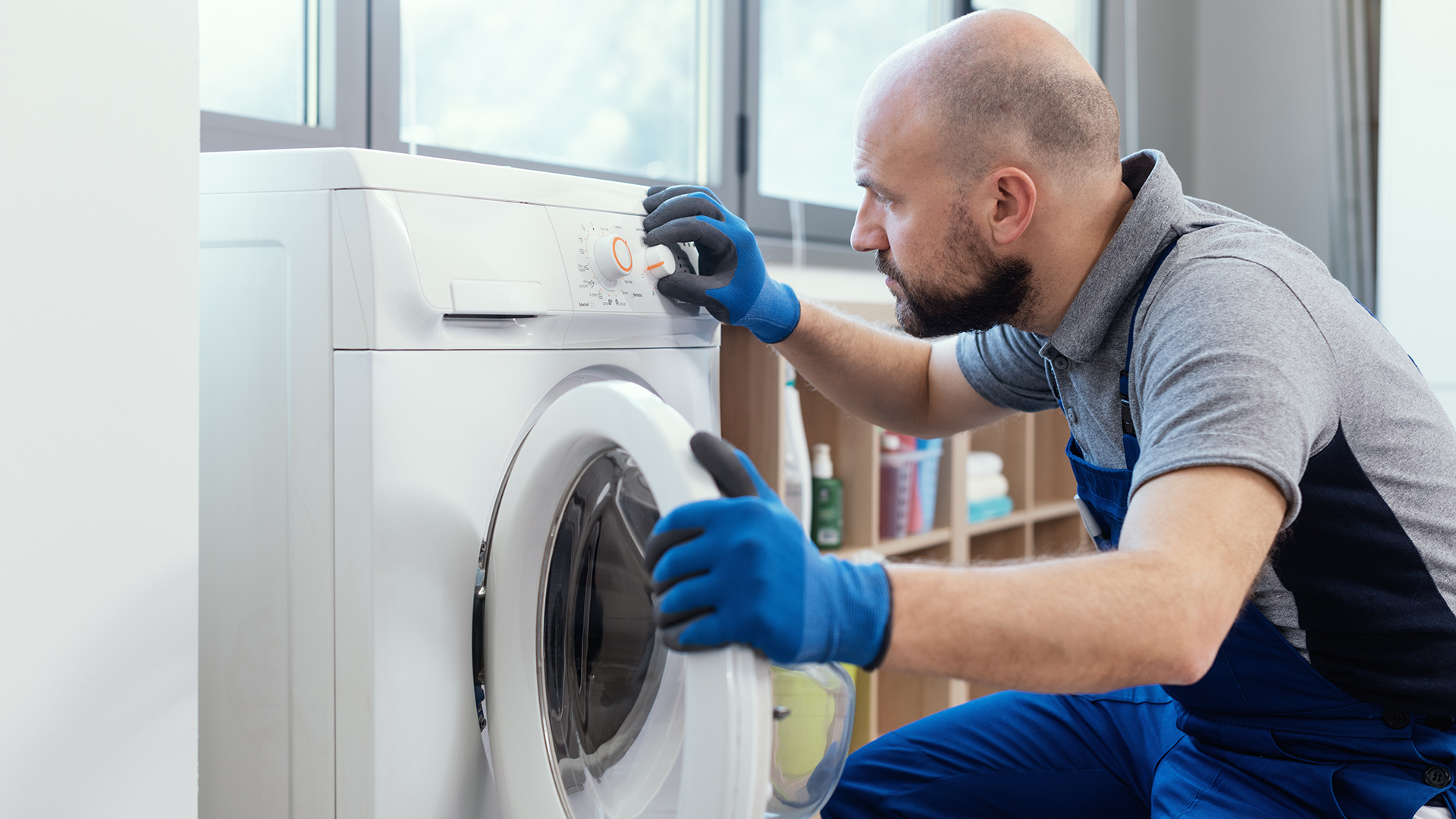Knowing how to repair a washer will help you get the most out of your machine. Perhaps it’s not cleaning your clothes as well as it used to, or it’s making a noise that doesn't sound right, but your washing machine may still have years of use left.
A washing machine works hard, so the occasional breakdown or change in performance is to be expected. The machine may struggle to drain, begin to vibrate, or may not start altogether. Either way, these are common problems that can be solved by the average Joe. That said, we’d always recommend you consult a specialist if your washing machine is faulty or you’re having other issues.
If you do choose to attempt to fix the machine yourself, be sure to consult the manufacturer's manual and also check the warranty to ensure that you don't void any cover by attempting to fix the problem yourself.
Even if you’ve invested in one of the best washing machines, whether front-load or top-load it’s not surprising your machine may slow down over time. So before you call your handyman, here are a few ways you can repair a washer machine on your own.

Joy Aumann is a licensed realtor (CIPS), interior designer and co-founder of the LUXURYSOCALREALTY team at COMPASS. 2021 and 2022 Wall Street Journal Real trends; ranked in the top 1,000 small real estate teams nationwide; two decades of luxury real estate and design experience staging homes; cited in major publications like The Wall Street Journal, Forbes, and Inc.

Ian Palmer-Smith is a Supplier and Heating Service Director at Domestic & General and a domestic appliance service and repair expert with over 35 years of professional experience.
How to repair a washing machine: Expert advice
We spoke to Tom Akers, Product Training at Miele, for his tips on how to repair a washer machine. We have outlined the common problems that many people encounter with washing machines and ways in which to troubleshoot below.
In addition, we also spoke to Ian Palmer-Smith, appliance repair expert at Domestic & General, and Joy Aumann, a licensed realtor (CIPS), interior designer, and co-founder of the LUXURYSOCALREALTY who share their experience to help you discern what the underlying cause of the problem may be.
Joy Aumann says: "Over the years, I’ve worked with a lot of professional cleaners and repair pros, and I’ve picked up a few tricks when it comes to keeping appliances, especially washing machines, running smoothly."
"If a washing machine stops working, the first thing to check is the power. It sounds obvious, but sometimes the outlet trips, and resetting it solves the problem."
Joy also explains that a lot of the common problems that cause machines to break down or require repair often come down to neglecting the general cleaning, care, and maintenance of the machine. For this, we do advise that you read our guide for how to clean a washing machine, as well as how to use a washing machine for tips, advice and best practice.
If in doubt, Ian Palmer-Smith advises: "I would recommend calling an expert to repair to ensure a safe and reliable fix. You should never try to fix an internal issue yourself unless you have the right training and experience."
"Consider the age of your appliance and potential cost of a repair when making your decision. If you are not comfortable with carrying out the checks to find the problem, it is best to seek help."
How to repair a washing machine: Common problems
- Loud noises
- Your machine won’t drain
- Your washing machine vibrates
- Your washer won't start
- The machine is leaking
How to repair a washing machine: Troubleshooting
1. Loud noises
“A loud noise could be due to an unbalanced load inside the machine (bath mats and heavy items are usually the culprits),” says Tom. They can bang against the side of the drum as it spins. If the load is extremely unbalanced, the drum may also not spin at all – if this happens, Tom suggests “adding a couple of dry towels can help balance the load.”
Joy Aumann advises a good clean of the machine to help with any strange noises:
"Keeping the machine clean is just as important. If it starts smelling bad, it's often because of detergent buildup, mold, or trapped moisture."
"Running a hot cycle with two cups of white vinegar (no laundry, just vinegar) helps break down residue and freshen things up. If there’s mold, especially around the rubber seal, scrubbing with a paste of baking soda and water, then wiping with vinegar, does the trick."
"The best way to prevent mold and smells is to leave the washer door slightly open after every load so it can air out. Also, wipe down the rubber seal regularly—that’s where a lot of gunk and trapped water collect."
2. Your machine won’t drain
Ian Palmer-Smith again advises to check the manufacturer's manual for troubleshooting or advice when it comes to drainage issues. Some models also display error codes which correspond to the problem, so checking the specifics for your machine is the best advice as the first step.
Ian says: "As a general rule, a machine that isn’t draining is likely to be caused by a clogged filter, blocked drain hose, or a mechanical fault."
To maintain the longevity of your washing machine, Ian advises:
"Make sure you always empty the pockets of your clothes and only use the recommended amount of detergent. Try to check and clean the filter once a week, and run a hot, empty cycle once a month to clean the machine."
Tom Akers advises that the first thing to check is the drain filter on the machine, which is usually located behind a little hatch at the bottom. Here’s how to drain your machine:
1. Find a tray
Grab a tray and place it below the filter.
2. Start to unscrew the filter
A washing machine can hold a lot of water, so unscrew the filter slowly to catch the water with your tray.
3. Empty the tray
Once the tray is full, empty the tray and repeat until the flow of water has slowed enough to fully unscrew and remove the filter.
4. Check for blockages
There may be an object, such as a button or coin, that has blocked the filter. If there is, remove it and replace the filter.
Joy Aumann asserts that many people forget that lint buildup also occurs in washing machines - not just dryers. Joy advises locating the lint filter in your machine, either near the drain pump or inside the drum.
She says: "Check your manual to find it and clean it out every so often. It helps the washer work better and prevents clogs."
3. Your washing machine vibrates
A vibration could be something as simple as the machine itself not being balanced. To correct this, Tom advises “to check the feet of the machine and adjust it to make sure it is properly level – a spirit level can be used.”
Is your front load washer on a solid floor? Tom states, “If the machine is placed on a suspended floor, this can also cause vibrations. The only resolution here would be to move the machine onto a solid floor or strengthen the floor underneath.”
A vibrating washing machine can be extremely loud and irritating, so you'll want to get it sorted quickly. It can also cause damage to your floor or other appliances around it. Luckily, learning how to level a washing machine at home is relatively easy to fix yourself, so you can avoid paying a professional unless the issue seems more serious.
Joy Aumann explains that the machine must be level or it's likely to vibrate. She advises: "Put both hands on the top of the washer and try rocking it back and forth—if it moves, the legs underneath need adjusting. Most washers have little adjustable feet that you can twist to raise or lower each corner. Keep adjusting until the machine sits flat and doesn’t wobble."
4. Your washer won't start
As simple as it sounds, the first thing to check if your washer won’t start is the plug socket. Make sure your washing machine is switched on. Otherwise, plug your machine into another available socket. If the machine still isn't starting, then you can eliminate the issue with the socket.
Next, Tom suggests checking the fuse in the plug if you can. “If this does not resolve the issue, then it’s time to call a service technician to check the machine.”
If the issue is related to the drum not spinning, Joy Aumann explains that it could be due to a worn-out belt inside the machine, which requires expert repair.
Ian Palmer-Smith also advises calling in a professional technician to fix the issues. Ian says: "It might be that the motor has given out, or the drive belt is faulty. Every washing machine is different, so it’s hard to know what’s wrong without getting an expert to take a look."
4. The machine is leaking
Ian Palmer-Smith is very clear advising that if you are experiencing leaks, it's advisable to get professional technician in to check your machine.
"Washing machines are electrical items, so this means there are significant risks of electric shocks if water gets near any electrical components. This is why it is important to be safe with your checks, and call an expert for a washing machine repair if you are unsure. Before carrying out any checks to identify the source of the leak, make sure the appliance is switched off and unplugged."
Ian explains that a common cause for a leaking washing machine is often due to problems with the water pump or the internal hoses of the machine. On most washers, the pump filter is located at the base of the machine.
Ian advises placing down a towel or bucket to collect any excess water. Then simply remove the pump filter panel to unscrew the filter. Clean out any debris and check the seal, which might be causing the leak.
Ian says: “To check the hoses, you can wrap kitchen roll or toilet paper around them and run a short cycle; if the paper is wet, this could mean there is a leak. Inspect the hoses for any rips or tears, and finally check the seals. If you find a rip, the hose will need to be replaced."
Ian also explains that if water collects at the front of the machine, the door may be responsible for the leak.
He advises: "Always make sure it is firmly shut before starting a wash cycle. Pull back the gasket, which is the door’s seal, and inspect it thoroughly for any rips or wear and tear. The gasket can get damaged over time from sharp clothing items like zips, or small objects left in clothes during the washing process."
Ian adds that another reason for leaks can be as simple as overloading a machine. He says:
"If you spot a leak, try running an empty cycle to determine whether it was simply because your machine was over-filled."
Joy Aumann also explains a simple reason why you may experience leaks; it may just be down to a loose hose, which can easily be tightened by hand or with pliers.
How to repair a washing machine: Q&A
When should you call an expert to repair the washer?
As our experts have explained, depending upon the issue, there are a number of problems that can have very simple underlying causes, and can be investigated and fixed fairly easily. If you're experiencing any of these problems, you can follow the steps outlined for each to discern what the problem may be and in some cases, attempt a fix.
However, in some circumstances, for instance often times with leaks, it's highly recommended that you seek out professional help to inspect and fix your machine.
Ian says: "A washing machine leak is a frustrating problem, and should be dealt with as quickly as possible. If you’ve tried everything and had no luck, your washing machine probably needs a professional repair."
How to repair a washing machine: Final Thoughts
The common problems listed are simple to troubleshoot and solve yourself, with some know-how.
Follow these expert tips to repair your washing machine, without needing to call out an expensive technician.
As always, we advise you to consult the manufacturer's guidelines and manual before you repair anything.
It's important to be aware that DIY repairs may also void any warranty, so do be sure to check the specifics for your machine.
If you're looking to upgrade your washing machine, check out the latest deals below.

